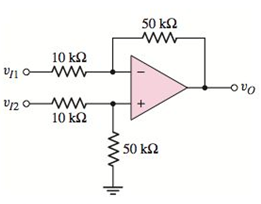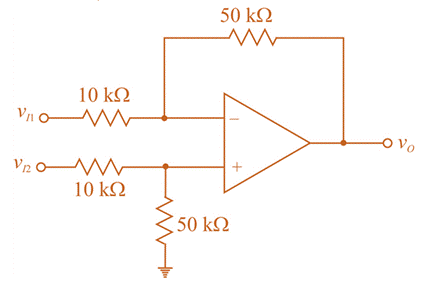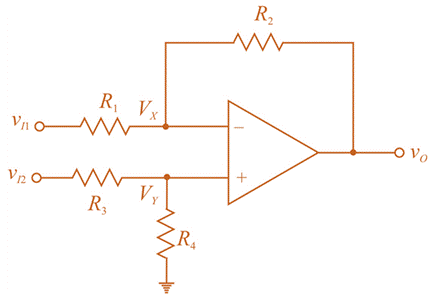
The op−amp in the difference amplifier configuration in Figure P14.60 isideal. (a) If the tolerance of each resistor is ± 1.5%, determine the minimum value of

Figure P14.60
a.
Minimum value of
Answer to Problem 14.60P
Explanation of Solution
Given:
The given difference amplifier circuit is shown below.

Tolerance of each resistor is
Calculation:
Circuit with voltage and resistance notation is,

KCL at
As op-amp is ideal, so
KCL at
Now put
Now,
If
For
For
Now,
For minimum CMRR maximize the denominator i.e.
and
Therefore,
So, minimum value of
b.
Minimum value of
Answer to Problem 14.60P
Explanation of Solution
Given:
The given difference amplifier circuit is shown below.

Tolerance of each resistor is
Calculation:
For tolerance of resistor
As,
For minimum CMRR maximize the denominator that is,
and
Putting the value in equation (3),
So, minimum value of
Want to see more full solutions like this?
Chapter 14 Solutions
Microelectronics: Circuit Analysis and Design
- Refer to the logic diagram of Figure. Gate 1 and gate 4 belong to the standard TTL family, while gate 2 and gate 3 belong to the Schottky TTL family and the low-power Schottky TTL family respectively. Determine whether the fan-out capability of gate 1 is being exceeded. Relevant data for the three logic families are given in Table 3(a).arrow_forward2. An existing system uses noncoherent BASK. The application requires a BER of <10^-5. The current transmit power is 25 Watts. If the system changes to a coherent BPSK modulation scheme, what is the new transmit power required to deliver the same BER?arrow_forwardfunctions: where are the Cauchy-Riemann equations satisfied by the 1- w = z² - 4 2- w = 7 Z Z+5 3- w = Z-2 z+1arrow_forward
- Find the integral for ezz Cz-i ezz Zdz and $c (z-i)³ dzarrow_forwardDetermine the voltage across A and B in the circuit given below:arrow_forwardAn inductive coil having negligible resistance and 0.1H inductance is connected a supply of 220V, 50 Hz. Calculate (a) Inductive reactance, (b) RMS value of Current, (c) Power consumed, (d) Power factor, (e) Write down the equations for voltage and current.arrow_forward
- If Fourier transform of f(t) is F(w) find Fourier transform of g(t) using only properties. d g(t) = f(2t)+8(3-1)+ ej(t-1)f(t) dtarrow_forward3z²+7z+1 dz (b) If C is the circle |z+i|=1. What is the value of S (a) If C is the circle |z+1|=1. z+1 (c) If C is the ellipse x²+y2=8.arrow_forward= Find the residues of all the poles of f(z) = 3z (z+2)²(z²-1)arrow_forward
 Introductory Circuit Analysis (13th Edition)Electrical EngineeringISBN:9780133923605Author:Robert L. BoylestadPublisher:PEARSON
Introductory Circuit Analysis (13th Edition)Electrical EngineeringISBN:9780133923605Author:Robert L. BoylestadPublisher:PEARSON Delmar's Standard Textbook Of ElectricityElectrical EngineeringISBN:9781337900348Author:Stephen L. HermanPublisher:Cengage Learning
Delmar's Standard Textbook Of ElectricityElectrical EngineeringISBN:9781337900348Author:Stephen L. HermanPublisher:Cengage Learning Programmable Logic ControllersElectrical EngineeringISBN:9780073373843Author:Frank D. PetruzellaPublisher:McGraw-Hill Education
Programmable Logic ControllersElectrical EngineeringISBN:9780073373843Author:Frank D. PetruzellaPublisher:McGraw-Hill Education Fundamentals of Electric CircuitsElectrical EngineeringISBN:9780078028229Author:Charles K Alexander, Matthew SadikuPublisher:McGraw-Hill Education
Fundamentals of Electric CircuitsElectrical EngineeringISBN:9780078028229Author:Charles K Alexander, Matthew SadikuPublisher:McGraw-Hill Education Electric Circuits. (11th Edition)Electrical EngineeringISBN:9780134746968Author:James W. Nilsson, Susan RiedelPublisher:PEARSON
Electric Circuits. (11th Edition)Electrical EngineeringISBN:9780134746968Author:James W. Nilsson, Susan RiedelPublisher:PEARSON Engineering ElectromagneticsElectrical EngineeringISBN:9780078028151Author:Hayt, William H. (william Hart), Jr, BUCK, John A.Publisher:Mcgraw-hill Education,
Engineering ElectromagneticsElectrical EngineeringISBN:9780078028151Author:Hayt, William H. (william Hart), Jr, BUCK, John A.Publisher:Mcgraw-hill Education,





